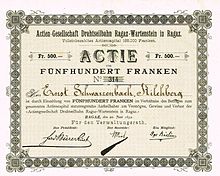Wartensteinbahn
| Ragaz – Wartenstein | |||||||||||||||||||||||||||||||||
|---|---|---|---|---|---|---|---|---|---|---|---|---|---|---|---|---|---|---|---|---|---|---|---|---|---|---|---|---|---|---|---|---|---|
| Route length: | 0.788 km | ||||||||||||||||||||||||||||||||
| Gauge : | 1000 mm ( meter gauge ) | ||||||||||||||||||||||||||||||||
| Maximum slope : | 303 ‰ | ||||||||||||||||||||||||||||||||
| Rack system : | from roll | ||||||||||||||||||||||||||||||||
|
|||||||||||||||||||||||||||||||||
The Wartensteinbahn (actually: Ragaz – Wartenstein (RW) cable car ) was a funicular in the Swiss canton of St. Gallen . It led from Bad Ragaz (until 1937 Ragaz) to Wartenstein in the Pfäfers community . The funicular existed between 1892 and 1964.
history
When the funicular was built, Ragaz was one of the most important health resorts in Switzerland. The 36.5 degrees warm healing water has been piped from the Tamina valley to Ragaz since the 19th century .
The funicular was built by Von Roll AG , Bern, to bring bathers from Ragaz to the Hohe Wartenstein, a promontory just before Pfäfers. From the Wartenstein, the spa guests had a wonderful view of the surrounding mountains and the Chur Rhine Valley .
The line was opened on August 1, 1882 and was last used on October 25, 1964.
route
The line with an operating length of 788 meters and a construction length of 796 meters left the 520 m. ü. M. located valley station over a short bridge and climbed with an average gradient of 27% towards the 227 meters higher Wartenstein (station 747 m above sea level). The greatest gradient was 30.3%. The first section of the route is driven under from the road to Pfäfers in a tunnel. Later an 80 m long curved viaduct with seven arches follows. After the diversion in the middle of the route, the 51 m long St. Niklausen tunnel under the road, the second viaduct and the 21 m long Wartenstein tunnel follow .
technology
The runway was driven directly by water ballast . The car going downhill pulled the car going uphill with a full water tank. At least until 1920, no maintenance or renovation work worth mentioning was carried out.
Rolling stock
The Ragaz-Wartenstein-Bahn had two passenger cars with 28 seats. There were no vehicles of their own for the low freight traffic of around 20–30 t per year; it was settled with the two passenger cars.
business
The railway was only operated in the summer months. Forty to sixty courses a day were held in the interwar period. The freight traffic with usually twenty to thirty tons per year is extremely low. The surprisingly high workforce of 7 people was reduced to 4 by 1918, without any significant loss of the timetable.
When the Aktien -Gesellschaft Drahtseilbahn Ragaz-Wartenstein was founded in Ragaz, 270 shares with a nominal value of 500 francs were issued. There was also a bond. The face value was reduced to 100 francs over time and then increased again to 150 francs. Up until the outbreak of the First World War , the share capital earned three to four percent interest, after which the profits were too small.
Todays situation
The route has largely been preserved, especially the two viaducts and tunnels. The valley station has been converted into a residential building; the bridge at the station exit is missing. The mountain station was canceled; the foundations were largely covered when the road was widened.
According to media reports in December 2019, the railway is to be reactivated by 2020.
Web links
- www.wartensteinbahn.ch
- Information at www.sarganserland-walensee.ch
- Swisstopo, time travel through old maps with the course of the route
Individual evidence
- ↑ a b c d e f g h Frey Thomas and Schiedt Hans-Ulrich / ViaStoria (eds.): Bahndaten.ch; (July 4, 2011).
- ↑ Swiss railways, mountain railways and trams (July 4, 2011)
- ↑ a b Funimag (July 4, 2011).
- ↑ Verkehrsrelktionen.uue.org (July 4, 2011).
- ↑ Historical Securities (July 4, 2011).
- ↑ The situation today (July 4, 2011).


